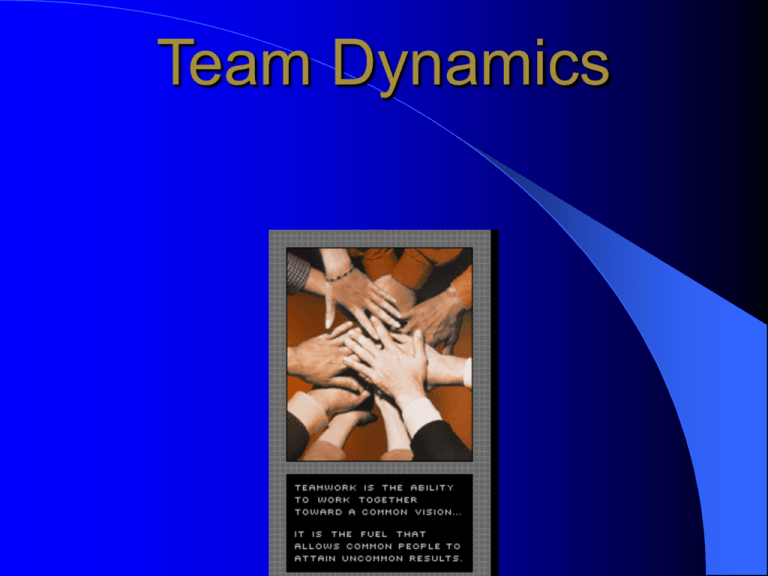Team dynamics
advertisement

Team Dynamics What are teams? Groups of two or more people Exist to fulfil a purpose Interdependent - interact and influence each other Mutually accountable for achieving common goals Perceive themselves as a social entity Groups versus teams All teams are groups Some groups are just people assembled together Teams have task interdependence whereas some groups do not (e.g. group of employees enjoying lunch together) Types of teams and groups Permanent Formal teams Informal groups Temporary Production team Management team Task force Friendship group Communities of practice Why informal groups exist Innate drive to bond – fulfil need for social interaction – social identity Goal accomplishment Emotional support Team effectiveness model Organisational and team environment Team design • Reward systems •Task characteristics • Communication systems •Team size •Team composition • Physical space • Organisational environment • Organisational structure • Organisational leadership Team processes •Team development •Team norms •Team roles •Team cohesiveness Team effectiveness • Achieve organisational goals • Satisfy member needs • Maintain team survival Team design features Task characteristics – better when tasks are clear, easy to implement – share common inputs, processes or outcomes – task interdependence Team size – smaller teams are better – but large enough to accomplish task Team composition – members motivated/competent to perform task in a team environment – team diversity High Levels of task interdependence A Reciprocal B Sequential A C B C Resource Low Pooled A B C Homogeneous vs. heterogeneous teams Homogeneous teams Heterogeneous teams Less conflict More conflict Faster team development Longer team development Perform better on cooperative tasks Perform better on complex problems Better coordination More creative High satisfaction of team members Better representation outside the team Stages of team development Performing Norming Storming Forming Existing teams might regress back to an earlier stage of development Adjourning Team norms Team establishes informal rules and expectations to regulate member behaviours Norms develop through: – explicit statements – critical events in team’s history – initial team experiences – beliefs/values members bring to the team Conformity to team norms 100 Units pressed per hour Day 12: Peer pressure begins 75 Day 28: Employee has doubled performance 50 25 0 Day 20: Employee begins working alone Day 1: Employee begins job with team 4 8 12 16 20 24 28 Production days 32 36 40 Changing team norms Introduce norms when forming teams Select members with preferred norms Discuss counter-productive norms Reward behaviours representing desired norms Disband teams with dysfunctional norms Influences on team cohesiveness Member similarity External challenges Team success Team size Team cohesiveness Somewhat difficult entry Member interaction Team cohesiveness outcomes Members of cohesive teams: want to remain members willing to share information strong interpersonal bonds resolve conflict effectively better interpersonal relationships Cohesiveness and performance Team norms support company goals Team norms oppose company goals Moderately high task performance High task performance Moderately low task performance Low task performance Low team cohesiveness High team cohesiveness The trouble with teams Individuals better/faster on some tasks Process losses - cost of developing and maintaining teams Companies don’t support best work environment for team dynamics Social loafing How to minimise social loafing Make individual performance more visible – form smaller teams – specialise tasks – measure individual performance Increase employee motivation – increase job enrichment – select motivated employees







